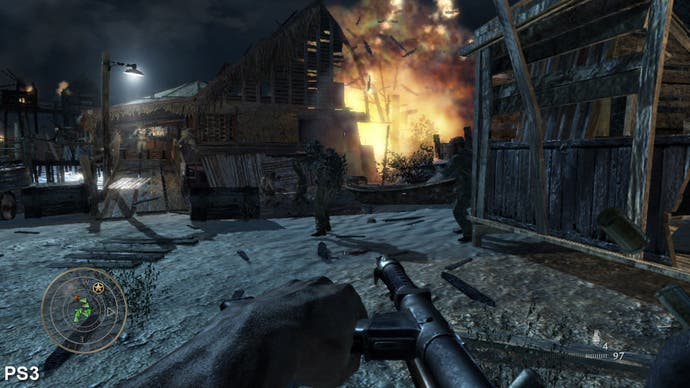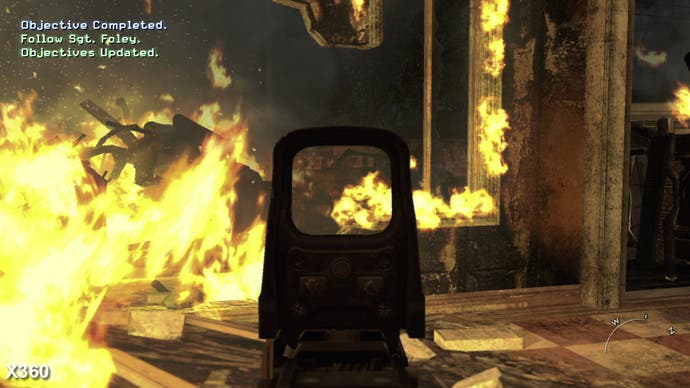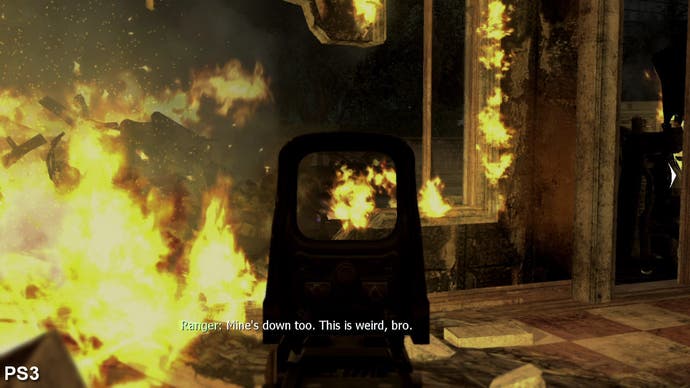Face-Off: Modern Warfare 2
Extensive analysis of the PS3 and Xbox 360 versions.
There's no two ways about this - the Xbox 360 version of the game commands a significant frame-rate advantage over the PS3 build. Let's kick off with perhaps the fairest and most accurate form of analysis: like-for-like video where we can assume that the engine is under equivalent load in mostly scripted scenes. In this case, we have included two different tests.
First up, there's the cannon section from the first mission - very scripted, very tightly defined, and very enclosed environments. Next up, the helicopter sniper assault on the gulag: a good test of the game's brand new, far more open levels made possible by the new streaming tech.
What is quite remarkable about this is that in the like-for-like scenes there is a pretty consistent performance difference between the PS3 and Xbox 360 versions of the game: a substantial 12 frames per second. Assuming that the exact same stuff is being drawn, it really does suggest the bandwidth is the issue here - if there is indeed the same amount of overdraw (i.e. transparent textures upon textures), it points to a consistent difference in performance level in terms of pure pixel fill-rate.
It's clear that the sheer amount of transparency effects Infinity Ward has in play causes both versions of Modern Warfare 2 to drop frames, but the impact is that much more substantial on the PlayStation 3. So can this also be measured during more intensive on-the-ground gunplay? We can certainly give it a try. One of the most performance-impacted stages in the whole game is in "The Hornet's Nest" during Act II. We have a series of clips taken from the same parts of the level, but obviously the actual action is very different.
The idea here is to use a technique more commonly used with PC benchmarking: play the same sections of the game through and look at overall averages and trends.
Some pretty hardcore action there, and in the midst of the blasting, moments of 60FPS updates are rare, occurring most frequently when ducking behind cover to heal (conveniently dropping render overheads significantly). It's fairly obvious to see that across the whole, the performance impact is significant on both platforms, but it's definitely the Xbox 360 game that provides the smoother and thus more responsive gameplay experience. Statistically speaking, Xbox 360 ran with a 56.44FPS average in the above video with a 41FPS minimum and a 60FPS max. PS3 averages 51.82FPS, with a 33FPS minimum and of course the requisite 60FPS max. The logical conclusion is that both aspire to the best frame-rates, but under load, it is the PS3 version that is most impacted.
What is curious is that in PS3 development in general, this whole transparency/bandwidth issue has had the edge taken off it to some degree through the widescale use of lower-resolution buffers that are then scaled up when rendering the frame. The result is that while effects like explosions, flames and smoke are a lower resolution, the human eye finds it difficult to tell the difference up against a full resolution buffer. Just about everyone is using this technique - even the most talented of Sony's first-party developers. Indeed, even the Call of Duty team in Treyarch used this technique in the alpha-heavy World at War. But Infinity Ward has not, the buffer sizes appear to be an exact match for the Xbox 360 game, and we can't help but feel that this has a lot to do with the performance difference.




It's intriguing to see that Infinity Ward has not used this technique at all to lessen the undoubted bandwidth burden, and it is interesting to note that Treyarch's World at War feels much more stable in alpha-heavy scenes. We can only assume that for Infinity Ward, image quality is of a higher priority than frame-rate. However, this does seem rather at odds with its publicly stated commitment to the lowest possible latency on controller feedback.
At the end of the day, in terms of the buying decision, the sheer importance of the game's multiplayer component is such that it's your choice of friends list that is going to determine which version of Modern Warfare 2 you buy. While the PS3 version has had some early glitches, bugs and party issues, it's also readily apparent that Infinity Ward is continually working to make sure the game works as it should.
However, for those that haven't made up their minds, it's fairly easy to say that while both renditions of the game are well worthy of the Eurogamer 9/10 score, the Xbox 360's marginally superior visuals and significantly smoother performance gives it an undoubted edge over the PlayStation 3 game, and this translates directly into a tangibly better gameplay experience.
Next up: Digital Foundry will be taking a look at the PC version of the game. Is it indeed the "console port" that the hardcore PC FPS enthusiasts have been dreading, or has Infinity Ward offered up the definitive version of the hottest game of the year?
Many thanks to MazingerDUDE and Alex Goh for their titanic input into this feature.








